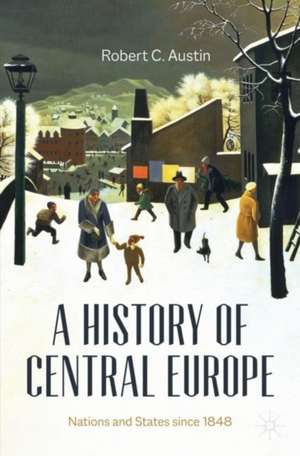A History of Central Europe: Nations and States Since 1848
Autor Robert C. Austinen Limba Engleză Paperback – oct 2021
Preț: 197.44 lei
Nou
Puncte Express: 296
Preț estimativ în valută:
37.79€ • 39.30$ • 31.19£
37.79€ • 39.30$ • 31.19£
Carte disponibilă
Livrare economică 24 martie-07 aprilie
Livrare express 08-14 martie pentru 23.52 lei
Preluare comenzi: 021 569.72.76
Specificații
ISBN-13: 9783030845421
ISBN-10: 3030845427
Pagini: 227
Ilustrații: XIII, 181 p.
Dimensiuni: 155 x 235 x 15 mm
Greutate: 0.31 kg
Ediția:1st ed. 2021
Editura: Springer International Publishing
Colecția Palgrave Macmillan
Locul publicării:Cham, Switzerland
ISBN-10: 3030845427
Pagini: 227
Ilustrații: XIII, 181 p.
Dimensiuni: 155 x 235 x 15 mm
Greutate: 0.31 kg
Ediția:1st ed. 2021
Editura: Springer International Publishing
Colecția Palgrave Macmillan
Locul publicării:Cham, Switzerland
Cuprins
1. Introduction: Flashpoints on the Road to 1918.- 2. The Interwar Failures, 1918 – 1939
3.The Second World War in Central Europe.- 4. Making Most of Central Europe Communist.- 5. Communists in Power, 1948-1988.- 6.1989 – 2004: Roundtables, Streets Protests and the Long Journey Back to Europe.- 7. A New Central Europe or Past as Prologue?.
Notă biografică
Robert C Austin is Associate Director and Professor at the Centre for European, Russian, and Eurasian Studies, Munk School of Global Affairs & Public Policy, University of Toronto. His previous books include Making and Remaking the Balkans: Nations and States since 1878 (2019) and Founding a Balkan State – Albania’s Experiment with Democracy, 1920 – 1925 (2012). He lives in Toronto.
Textul de pe ultima copertă
This textbook offers a survey of the history of Central Europe since 1848, from the ‘Springtime of Nations’, through the world wars and communist period, to NATO and EU membership. With an emphasis on nation-building, it gives the reader a better understanding of not just political history but also of the region’s economic development and of everyday life. The book brings the reader right up to the present, considering contemporary issues such as the impact of the 2015 refugee crisis, migration out of Central Europe, the weakening of democratic institutions and the re-emergence of nationalism. Throughout, it offers fresh perspectives, gives agency to Central Europe, and pays attention to the ethnic, linguistic and religious diversity of the region. This is essential reading for students taking courses on Central/East-Central Europe. It is also suitable for courses on 19th and 20th Century Europe, or for anyone with an interest in the region.
Caracteristici
Offers a survey of the history of Central Europe since 1848 Considers contemporary issues such as the impact of the 2015 refugee crisis Provides fresh perspectives, gives agency to Central Europe
